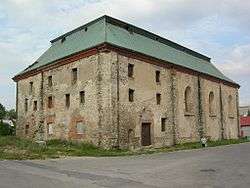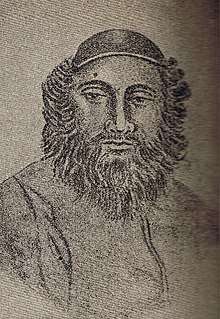Peshischa (Hasidic group)
Peshischa (Yiddish: פרשיסחא) is a hasidic school of thought based out of Przysucha, Poland founded by Yaakov Yitzchak Rabinowicz, which flourished during the late 18th to early 19th century. The school of thought became the bases for Kotzk Hasidism, Ger Hasidism, Amshinov Hasidism, Zychlin Hasidism, Aleksander Hasidism and Izhbitza-Radzin Hasidism. Following the death of the last contested Peshischa Rebbe, Menachem Mendel of Kotzk, Peshischa ceased to exist as a separate movement, yet its ideals still exist as the foundation for a large percentage of modern Hasidic groups. [1][2][3]

Yaakov Yitzchak Rabinowicz
Rabbi Yaakov Yitzchak Rabinowicz, commonly known as "The Holy Jew", founded a Hasidic movement in Przysucha, Poland. The Holy Jew preached rationalism, and aspects of secularism in staunch contrast to contemporary Hasidic movements. Peshischa Hasidim was different from its contemporaries in that they did not study Kabbalah and believed it to be too mystical and not grounded enough in rationality. The Holy Jew also preached the importance of authenticity and honestly with ones self. Popularizing an individual personal relationship with God as apposed to one manifested through a Rebbe. Following the death of The Holy Jew in 1813, the Peshischa community experienced a minor schism in regards to leadership because The Holy Jew did not believe in dynasties and thus his successor was not as clear. However shortly after his death, his main disciple, Simcha Bunim of Peshischa succeeded him.[4][5][6][7]
Simcha Bunim of Peshischa

Simcha Bunim Bonhart of Peshischa was one of the key leaders of Hasidic Judaism in Poland. It was through him that the Peshischa school of thought became the statues qua for many Hassidic movements. Born to an orthodox non-hasidic family, in his early years, Rabbi Simcha Bunim studied science, mathematics, history and linguistics at the leading universities in Austria. It was this secular education which Rabbi Simcha Bunim unprecedentedly juxtaposed to modern Hasidic thought in Poland. In 1813 he became the First Grand Rabbi Peshischa and began to revolutionize the school of thought, and Hasidism as a whole.[8] Under his leadership, Peshischa Hasids were required to learn the works of Maimonides as well minor secular mathematic and scientific works.[2] Besides the main teachings of The Holy Jew, Rabbi Simcha Bunim preached the importance of independence and non-conformity. Unlike the Hasidic movements of his time, Rabbi Simcha Bunim believed that it was crucial for his disciples to be independent of their rebbe. He taught his students to develop the ability to learn and think critically without him. This challenged and threatened contemporary Hasidic leadership who believed in the Autocratic nature of Rebbes.[9] Rabbi Simcha Bunim also preached the idea of non-conformism. He encouraged his pupils to embrace their uniqueness and to resist peer pressure in any form.[10] Amongst his followers were: Menachem Mendel of Kotzk, the founder of the Kotzk dynasty, Yitzchak Meir Alter, the founder of the Ger dynasty, Israel Yitzhak Kalish, the founder of the Warka dynasty and Mordechai Yosef Leiner, the founder of the Izhbitza-Radzin dynasty. Each of his followers incorporated his teachings as the foundation for each of their movements. After his death in 1827, Peshischa split into two factions, those who supported Menachem Mendel of Kotzk as Simcha Bunim's successor and those who supported the succession of Simcha Bunim's son Rabbi Avraham Moshe Bonhart. However, after Avraham Moshe's death a year later in 1828, the community almost unanimously followed Menachem Mendel, who gradually incorporated most of the community into Kotzk. After his death in 1859, Peshischa ceased to exist as a separate movement, yet its ideals still exist as the foundation for a large percentage of modern Hasidic groups.[11]
Succession
- Yaakov Yitzchak Rabinowicz, founder of the Peshischa school of thought.
- Simcha Bunim Bonhart of Peshischa, First Grand Rabbi of Peshischa. (1813-1827)
- Avraham Moshe Bonhart, Second Grand Rabbi of Peshischa. (1828)
- Menachem Mendel of Kotzk, Third Grand Rabbi of Peshischa. (1828-1859)
- Avraham Moshe Bonhart, Second Grand Rabbi of Peshischa. (1828)
- Simcha Bunim Bonhart of Peshischa, First Grand Rabbi of Peshischa. (1813-1827)
References
- "The Master of Peshischa". Segula Magazine.
- "Peshischa Hasidim | Virtual Shtetl". sztetl.org.pl. Retrieved 2020-06-27.
- Dynner, Glenn Davis (2009), "Pshiskhe Hasidic Dynasty," The YIVO Encyclopedia of Jews of Eastern Europe, YIVO.
- Shapiro, Rami M. (2003). Hasidic Tales: Annotated & explained. Skylight Paths Publishing. p. xxxix. ISBN 1-893361-86-1.
- Dynner, Glenn Davis (2009), "Pshiskhe Hasidic Dynasty," The YIVO Encyclopedia of Jews of Eastern Europe, YIVO.
- "The Yid Hakodosh". en.hidush.co.il. Retrieved 2020-06-27.
- "Przysucha (Pshishkha), Jacob Isaac ben Asher". www.jewishvirtuallibrary.org. Retrieved 2020-06-27.
- "The Master of Peshischa". Segula Magazine.
- Rosen, Michael, 1945-2008. (2008). The quest for authenticity : the thought of Reb Simhah Bunim (1st ed.). Jerusalem: Urim Publications. p. 40. ISBN 978-965-524-003-0. OCLC 190789076.CS1 maint: multiple names: authors list (link)
- Rosen, Michael, 1945-2008. (2008). The quest for authenticity : the thought of Reb Simhah Bunim (1st ed.). Jerusalem: Urim Publications. p. 206. ISBN 978-965-524-003-0. OCLC 190789076.CS1 maint: multiple names: authors list (link)
- Rosen, Michael, 1945-2008 (2008). The quest for authenticity : the thought of Reb Simhah Bunim. Urim Publications. ISBN 978-965-524-003-0. OCLC 837205625.CS1 maint: multiple names: authors list (link)